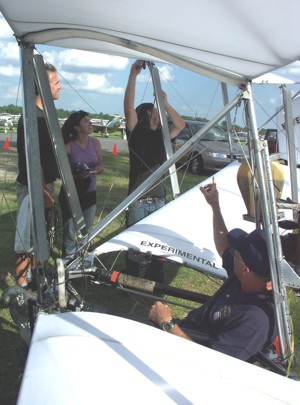
John K. Moody, a.k.a. the “Father of Ultralights,” directs a Discovery Channel crew as they attach small cameras to the Easy Riser’s leading edge.
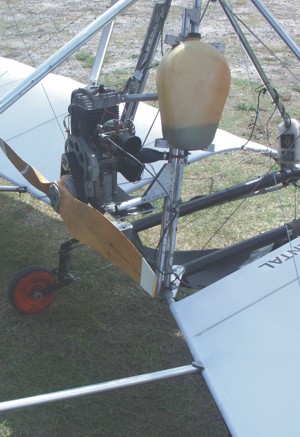
While this Part 103 legal ultralight’s cockpit may appear spartan, it in fact bristles with the controls and levers Moody uses while flying.
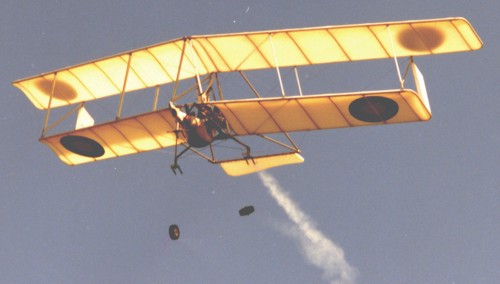
After losing his nosewheel to the “repo man,” off come Easy Riser’s maingear.
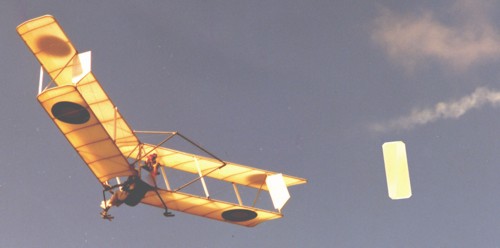
Moody’s plane appears to be in big trouble. All three of its landing gear have been shot off, and now a third shot takes off the horizontal tail shown fluttering away!
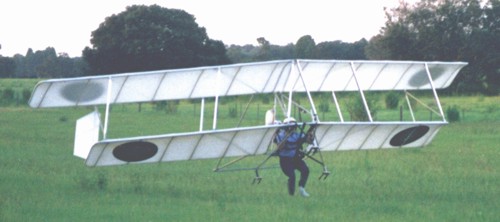
As the act comes to a close, Moody lands neatly on his feet sans wheel landing gear or horizontal tail, unbeknowst to spectators that the plane needs neither part to function.
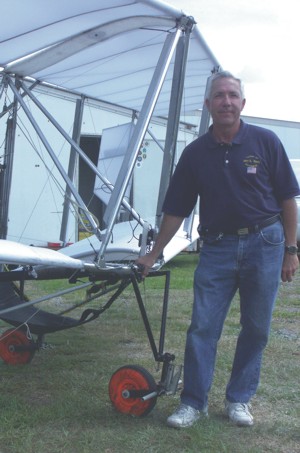
Moody shows off the Easy Riser’s day-glow orange wheels, which are painted this color so his crew can easily find them after they’ve been “blown off.”
John K. Moody is widely acclaimed as the “Father of Ultralights,” and he makes effective use of that unique title to publicize his new millennium act featuring his last millennium ultralight.
Is Moody really the father of ultralights or the first to fly one? Several other enthusiasts were experimenting with power units for various kinds of hang gliders in the mid-1970s when Moody started. His distinction was that he was the first person to foot-launch and climb from flat terrain without benefit of wind or a slope.
I saw Moody fly in the summer of 1975 when he performed before about 250 hang glider pilots in a contest on the sand dunes near Frankfort, perched on the eastern shore of Lake Michigan. He began this risky behavior on March 15, 1975, above a frozen lake southwest of Milwaukee, at age 32.
Into almost still winds at the end of a day of hang-gliding competition, Moody ran his heart out and coaxed his Icarus II biwing hang glider off the beach with a 10-hp West Bend engine giving him some push. After gaining a couple hundred feet he flew up and down the beach until he exhausted his fuel, and the engine suddenly quieted. I recall everyone was astonished-though the high and mighty of hang gliding acted nonchalant when he came around and landed lightly on his feet. In that single flight, Moody flew 10 times as long as I did in the entire weeklong contest. (Of course, our hang glider flights in those days were measured in minutes, and there were not very many of them at that.)
Pioneering Ultralight Businessman
With the help of the famous instructional book by Wolfgang Langewiesche, Stick and Rudder, Moody taught himself to fly. In the early 1970s that was common, although today-in the shadow of the Sport Pilot/Light-Sport Aircraft rule-it seems foolhardy. Clearly, Moody’s early investigations were pioneering.
He was one of the first to enter the ultralight business (CGS Aviation founder Chuck Slusarczyk was also involved early on). But Moody was so early in the game that no one even called it the “ultralight industry.” His Ultralight Flying Machines of Wisconsin developed power components and other gear to make the Icarus II or Easy Riser tailless biwing into a powered hang glider.
Near the beginning of ultralight aviation, Moody sold the Stewart Maximizer reduction drive, an elevator system mounted on a tail assembly (for those who were unsure of a powered tailless aircraft), specially developed crosswind landing gear that allowed all three wheels to swivel, permitting the two-control aircraft to operate in moderate crosswind conditions.
After Moody helped jump-start the ultralight industry, it began to develop rapidly. He eventually left the business, but his contributions have not been forgotten. In fact, his name is inscribed in history through an award issued in his name: The John Moody Award-the U.S. Ultralight Association’s highest honor.
Moody himself was the initial recipient, in 1991, of this award, which recognizes outstanding contributions to ultralight aviation. Thirteen industry leaders have been honored with the Moody, all of whom (including this author) owe a debt of gratitude for Moody’s experiments with powered hang gliders. He was also a Southeast Wisconsin Aviation Hall of Fame inductee in 1998 and in 1999, and he was the first inductee to EAA’s Ultralight Hall of Fame.
Over the years, Moody has been featured in numerous periodicals. His story has appeared in Popular Science, Popular Mechanics, Smithsonianand National Geographic as well as in a variety of aviation trade magazines.
Colorful Airshow Performer
Shortly after he began flying the Icarus II under power, Moody took his unusual flying machine to EAA’s Oshkosh event. One of his flights turned out to be a highly memorable event, producing a fascinating scene caught on videotape. People who witnessed it still talk about the unbelievable sight and Moody’s miraculous recovery.
During a routine where he performed steep wingovers to show the aircraft’s maneuverability, Moody got a bit overzealous and found himself hanging upside down. Following a short inverted phase, his powered, tailless Easy Riser entered a stunning series of four head-over-heels tumbles. Far too close to earth-a mere 50 feet off the deck-his Easy Riser flew out of the tumbles, and Moody was able to land without incident or injury.
Moody remains active in the Part 103 segment of ultralight aviation, and since 2002, he has also been pursuing the airshow circuit. He performs a one-of-a-kind comedy routine in his Hirth-powered, specially configured, vintage 1977 Easy Riser.
The announcer, sounding as if he has been caught off guard, reports that the pilot of the ultralight that just took off is apparently late on his aircraft payments. Suddenly a crazed repo man runs out on the field with a shotgun, seemingly bent on shooting Moody and his biwing aircraft out of the sky. His first shot misses Moody but takes off the nosewheel. Uh, oh! Another shot, and off come the maingear. Yipes, no gear at all! A third shot takes off the Easy Riser’s horizontal tail, which flutters away. Finally, before airshow officials can subdue the wild gunman, a fourth shot hits the engine, which begins sputtering and smoking.
Somehow, Moody maintains control with the aircraft flying erratically and brings it in neatly to a two-point landing on his legs. The crowd usually loves it even though they know they’ve been fooled. The Easy Riser needs no tail, and Moody has many times landed on his feet. The engine sputtering is a mouth control he developed, and the smoke is pure airshow technique.
Besides his work as a flying performer, Moody is a speaker for adult groups and schools, delivering a speech called Beginning of Ultralights. When Moody speaks to such groups, he can explain the details of flight to youngsters, but he also entertains all ages with interesting, often hilarious, and riveting video footage of his early flying exploits-including the Oshkosh incident. A man of strong faith, Moody also conducts religious services for performers and vendors at airshows, which are commonly held on Sunday when he would normally be at church.
For further information on when you might see Moody perform his entertaining act, visit his website or note listings provided by the International Council of Airshows.
FOR MORE INFORMATION, contact John K. Moody at 813/685-2718 or visit www.pioneerflyer.com.
TO REVIEW ALL “Light Stuff” columns that have appeared in KITPLANES®, visit www.ByDanJohnson.com, which links to the KITPLANES® website with articles of interest.


Leave a Reply